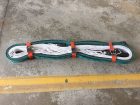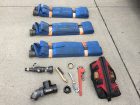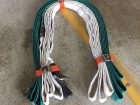
Tim-bits July 2017: Stretching from the standpipe
By Tim Llewellyn
Features Structural Training annex Canada Equipment firefighterIn the April issue, I reviewed the general flow and pressure characteristics of standpipe systems based upon the year of their installation or upgrade. For review, standpipe systems installed before 1993 are designed to produce a flow of 500 gpm at 65 psi – which produces a good combination of volume and pressure for a 65 millimetre (2.5 inch) hose with a smooth-bore tip.
The 1993 edition of NFPA 14: Standard for the Installation of Standpipe and Hose Systems, had a few changes. Most significantly, the pressure requirements were increased from 65 psi to 100 psi. So, systems that were installed or upgraded after 1993 should produce a flow of 500 gpm with 100 psi residual pressure. As pressure increased, the standard also permitted the use of smaller handlines, such as 38 mm (1.5 inch) or 45 mm (1.75 inch) with fog nozzles, which were in wide use.
Like many things in the fire service, there is a great amount of debate about which size of hose is appropriate when using a standpipe connection to fight a fire. Despite the differences in pressure requirements, fire departments from across North America have had successes and failures using 38 mm, 45 mm and even 65 mm hoses. Your department should decide what size hose to use based on practical testing and evaluation of flow characteristics, crew size and ability, and anticipated fire stream performance. Regardless of what hose and nozzle combination your department chooses, there must also be an effective method of packing, transporting and deploying this equipment to the fire floor. In this column, I will describe a few methods of packing both large and small diameter attack lines that we have found to be successful.
The first method that works successfully with smaller handlines is the Cleveland load. This hose load has become very popular and has been used for years in the forestry fire service. There are many discussions and video resources online about the Cleveland load that illustrate how to pack and deploy it. The main advantages of this type of hose load are that the line is charged before it is deployed or stretched out, allowing firefighters to begin fire attack sooner; and all of the charged hose is staged in one small area, rather than stretched up stairwells and down hallways. This deployment method may stop hose couplings from snagging on doorframes or around other obstacles. One major limitation of the Cleveland load is that the hose cannot be deployed when it is not charged. Attempting to deploy the hose before it is charged could result in numerous twists and kinks that will need to be unwound, major delays when putting water on the fire, and the potential to put firefighters in great danger.
The second method with which we’ve had success for our 45 mm lines is a standard-service load, otherwise known as a flat load. This type of load is beneficial primarily because the deployment technique is exactly the same as it is for our apparatus-mounted cross lays. The standard-service load reduces the amount of required training because it is simply laid on the ground and folded back and forth, accordion-style. The two sections of hose are then bundled together with three straps. A bundle can be easily carried by one firefighter. Our standard deployment for this tactic is two bundles from each assigned engine to the fire floor. For deployment, the firefighter at the nozzle advances six metres (20 feet) forward, while the backup firefighters make the standpipe connection and stretch the back section up the stairwell or toward the nozzle. Unlike the Cleveland load, the flat load must be stretched out while the hose is dry before it can be charged with water.
For a 65 mm hose, our department has found great success with the FDNY load. This method takes each section of hose and folds and bundles it individually. The load starts with a section of hose folded in half, but laid side-by-side. The bight end is then folded toward the coupling end. Repeat this folding until the overall length is reduced to about a metre long. Use two straps to hold the stacked bundle together. For deployment, the bundles are laid side by side in a manner so that the couplings can be connected. From here, the buckles are unfastened and the hoses are unfolded toward the fire area or in a reverse direction, depending on the building’s layout. It’s important to note that with the FDNY load, the nozzle is kept in a standpipe bag that accompanies the hose bundles; it is not already attached to a hose section. In addition to the nozzle, the bag should contain a rope hose tool, a spare standpipe wheel, a small pipe wrench, door chocks, a 65 mm gate valve with an inline pressure gauge, and other small tools that might come in handy.
Whatever type of hose-and-nozzle combination your department prefers to use with standpipes, it’s important that you get regular practice with this equipment. Fires in standpipe-equipped structures are not common calls for many departments, but are considered low-frequency, high-risk incidents, so get out there and practise your standpipe stretches before you have to respond to an incident.
Print this page
Advertisement
- Extrication tips July 2017: Throwing SHADE on your size-up
- Fit for duty July 2017: Simple ways to eliminate health hazards


